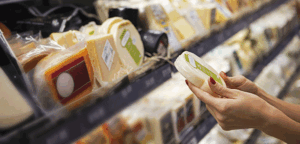
Developing and maintaining an effective, verifiable inspection process is no longer an option for dairy processors. Innovative technology is now available — which can detect foreign objects — while operating simply, efficiently and at high speed — and collecting and retaining important production run data.
“Even with the best plans — strict adherence to regulatory requirements — and tenacious monitoring, the possibility of a foreign object finding its way into your package is always present,” says Scott Burrows, sales and operations manager at Heat and Control.
He says that the right inspection equipment for your dairy application is an important decision and can be complex process. Working with an experienced food industry supplier, is the quickest and easiest way to can access to practical knowledge and support.
The first steps in choosing the right X-ray inspection system for your dairy application involve determining what product/s will be inspected and for what functions the equipment will be responsible for. Once that’s confirmed, there are a number of other important factors to consider:
• Generators – Within an X-ray machine, the generator produces the X-rays that are transmitted through the product and foreign bodies. The generator’s available power output (voltage and current) is an important specification in overall performance of the system.
• Line sensors – While most machines just have one sensor; multiple sensors can provide greater contrasting images, which is useful in applications that require the inspection of lower density contaminants such as glass.
• Diode pitch – Just as more pixels in digital cameras create clearer images, line sensors with a smaller diode pitch allow for better resolution and increased ability to detect smaller contaminants. However, smaller diodes can also magnify “noise” that leads to distortion in the image.
• Imaging software – The machine’s imaging software analyses the line sensor signals — to determine what’s foreign material — and what’s good product. The power and functions of the system’s imaging software can be the single most important factor in its overall ability to detect foreign material.
• Rejection – The size and weight of the products, as well as line speed, will factor into the decision. Either way, this mechanism is vital for removing bad products.
• Certification – X-ray is regulated by the FDA as well as state agencies; both users and vendors are typically required to follow various registration and usage procedures when installing and operating X-ray systems.
• Software – Software has a huge impact on the internal adoption of X-ray technology. Due to advances in technology, it is typically quick and easy to set up pre-sets.
• Application support – The results from X-ray inspection are dependent on the objects imaged and proper setup of the machine. For this reason, it’s important to work with an experienced equipment supplier, to help you align the equipment to your application.
• Training- While X-ray systems are not complex to understand, training is essential to build the knowledge to use them safely, compliantly and to maximise their effectiveness on your line.
• Cost of ownership – When choosing an X-ray machine to suit your requirements — consider the quality of training and assess what ongoing service and support is available before making your decision.
FLEXIBILITY OF X-RAY TECHNOLOGIES
To strengthen your quality control and assurance, X-ray machines can be used at the various critical control points (CCP) in your dairy production line. They’re commonly found at the end of the production line where they’re used to identify defects before products are dispatched and sent to the retailer.
Inspection of incoming ingredients — has the important benefit of protecting machinery and/or eliminating any contaminants — before they are fragmented into pieces by downstream equipment and become too small for inspection at your end-of-line CCP inspection points.
“Unsurprisingly, the same X-ray technologies may perform differently depending on the characteristics of your product. For example, performance can be reduced on thick, dense products, such as large blocks of cheese.”
In addition to inspecting for physical contaminants, X-ray systems are widely used to perform additional quality control checks such as estimating mass, counting components, identifying missing or broken products, monitoring fill levels, and inspecting seals for food entrapment.
ISHIDA IX SERIES FOR DAIRY
Choosing the right X-ray inspection system for your dairy operation will be highly dependent on your facility, and your application. An X-ray inspection system from Ishida is an excellent choice for many dairy applications. Their industry leading IX Series of X-ray systems — can detect foreign bodies of the lowest densities — while overcoming common challenges of running multiple products.
For example, Burrows says, if your line run an extensive range of products (with different sizes and weights) you’ll need to choose a machine that can handle the largest product by size — while also meeting speed and/or sensitivity requirements for your most smallest package.
“The IX Series is unique in the industry for using Ishida-patented Genetic Algorithms (GA) in its image processing technology. GA is fully adaptable to your specific application/s and will ensure a thorough inspection of your products [for the full spectrum of foreign bodies]and at unrivalled sensitivity levels.”
For more information contact Heat and Control by emailing
[email protected] or visit www.heatandcontrol.com.






























































































